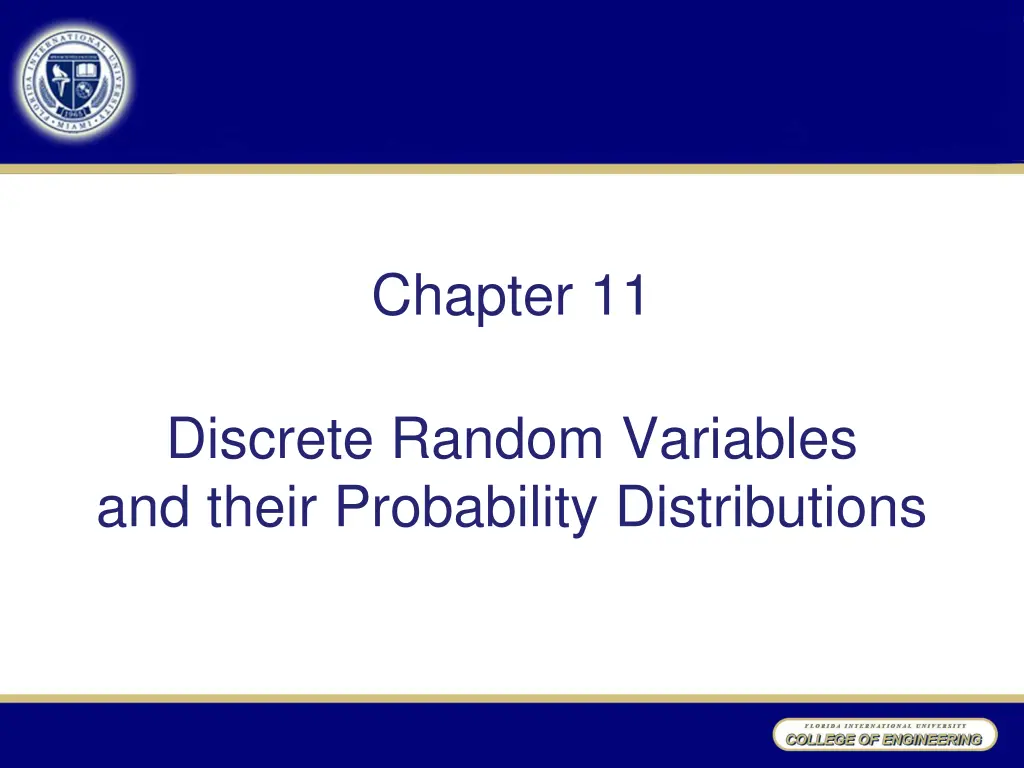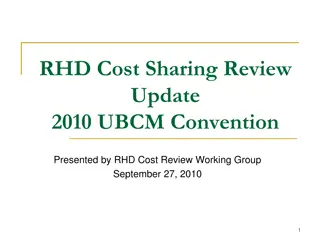
Understanding Discrete Random Variables
Explore the concept of discrete random variables and their probability distributions in this insightful guide. Learn about different types of random variables, examples, discrete vs. continuous variables, and probability distributions. Discover how to interpret outcomes and probabilities in a mathematical context.
Download Presentation

Please find below an Image/Link to download the presentation.
The content on the website is provided AS IS for your information and personal use only. It may not be sold, licensed, or shared on other websites without obtaining consent from the author. If you encounter any issues during the download, it is possible that the publisher has removed the file from their server.
You are allowed to download the files provided on this website for personal or commercial use, subject to the condition that they are used lawfully. All files are the property of their respective owners.
The content on the website is provided AS IS for your information and personal use only. It may not be sold, licensed, or shared on other websites without obtaining consent from the author.
E N D
Presentation Transcript
Chapter 11 Discrete Random Variables and their Probability Distributions
Random Variables A random variable is a numerical outcome of a random experiment A discrete random variable can take on only specific, isolated numerical values, Finite discrete random variables: Discrete random variables that can take on only finitely many values (like the outcome of a roll of a die) Infinite discrete random variables: Discrete random variables that can take on an unlimited number of values (like the number of stars estimated to be in the universe) A continuous random variable can take on any values within a continuous range or an interval (like the temperature, or the height of an athlete in centimeters.)
Random Variables Example Experiment: Next four customers who enter a bank Random variable x: the number of customers who make a deposit (D) x = 1 represents the event exactly one customer makes a deposit x Outcomes 0 NNNN 1 DNNN,NDNN,NNDN,NNND 2 DDNN,DNDN,DNND,NDDN,NDND,NNDD 3 DDDN,DDND,DNDD,NDDD 4 DDDD D represents a customer who makes a deposit, N represents a customer who does not.
Discrete vs. Continuous Random Variables DISCRETE CONTINUOUS Values that can be counted and ordered Gap between consecutive values Examples: 1) Insurance claims filed in one day 2) Cars sold in one month 3) Employees who call in sick on a day Values that cannot be counted On continuous spectrum Examples: 1) Time to check out a customer 2) Weight of an outgoing shipment 3) Distance traveled by a truck in a single day 4) Price of a gallon of gas Measure with a specific amount of precision
Probability Distributions of a Discrete Random Variable The distribution of a random variable is the collection of possible outcomes along with their probabilities. This may be described by a table, a formula, or a probability histogram. The probability assigned to each value of x lies in the range 0-1. The sum of all the probabilities of x must equal 1. 0 P ( x ) 1 =1 P (x )
Probability Distributions of a Discrete Random Variable: Example The probability distribution of x describes a list of all the possible values that a x can assume and their corresponding probabilities. x Outcomes P(X) 0 NNNN 1/16 = .0625 1 DNNN, NDNN, NNDN, NNND 4/16 = .2500 2 DDNN, DNDN, DNND, NDDN, NDND, NNDD 6/16 = .3750 3 DDDN, DDND, DNDD, NDDD 4/16 = .2500 4 DDDD 1/16 = .0625 CALCULATE the probability of : P(Exactly one depositor in four customers) or P(x=1) P(two or more depositors) or P(x 2) P(Fewer than four depositors) or (P(x<4)
Mean of a Discrete Random Variable The mean of a discrete random variable, , is actually the mean of its probability distribution. The mean is also called the expected value and is denoted by E (x). = = E ( x ) xP ( x ) x P(X) Outcomes xP(x) 0 NNNN 1/16 = .0625 0 (.0625)= 0 1 DNNN,NDNN,NNDN,NNND 4/16 = .2500 1 (.25)= .25 2 DDNN,DNDN,DNND,NDDN,NDND,NNDD 6/16 = .3750 2 (.375)= .75 3 DDDN,DDND,DNDD,NDDD 4/16 = .2500 3 (.25)= .75 4 DDDD 1/16 = .0625 xP(x) = 4 (.0625)= .25 2.00
Standard Deviation of a Discrete Random Variable The standard deviation, , of a discrete random variable measures the spread of its probability distribution. A higher value indicated that x can assume values over a larger range the mean. = 2 = 2 2 ( x ) P ( x ) x P ( x ) x x P(x) x P(X) xP(x) 0 1/16 = .0625 0 (.0625)= 0 0 0 = 1 4/16 = .2500 1 (.25)= .25 1 .25 2 2 x P ( x ) 2 6/16 = .3750 2 (.375)= .75 4 1.5 = 2 5 2 3 4/16 = .2500 3 (.25)= .75 9 2.25 4 1/16 = .0625 4 (.0625)= .25 16 1 = 1 xP(x) = x P(x) = 2.00 5
EXAMPLE: Discrete Random Variable Calculations Accidents do happen at Brown s Manufacturing Corp. Let x be the number of accidents that occur during a month, with their probability distribution. X 0 1 2 3 4 P(X) .25 .30 .20 .15 .10 Find:
Binomial Distribution A binomial experiment (also known as a Bernoulli trial) is a statistical experiment that has the following properties: The experiment consists of n repeated trials. Each trial can result in just two possible outcomes. We call one of these outcomes a success and the other, a failure. The probability of success, denoted by P, is the same on every trial. The trials are independent; that is, the outcome on one trial does not affect the outcome on other trials. Binomial probability distributions one of the most widely used discrete probability distributions
Combinations Combinations: Give the number of ways x elements can be selected from n elements. Combinations are expressed as nCx elements from which x elements are selected) Example: How many ways to combine managers A,B,C and D in groups of two? 6C2 AB,AC,AD,BC,BD,CD (so 6. Note that order doesn t matter). Calculated as: ( ! n x (meaning n n ! = Cx n x )! Calculate the above example (selecting 2 out of 6 managers) using the formula.
Binomial Probability Distribution The probability distribution of x in binomial experiments is called binomial (probability) distribution. The probability of exactly x successes in n trials is: Where P(x)= nCx pxqn-x n = total number of trials p= probability of success q= probability of failure = 1-p x=number of successes in n trials n-x= number of failures in n trials Example: 15% of engineering students work full time. Using the binomial probability formula find the probability that in a random sample of 5 students, the number who work full time is: (a) exactly 0 (b) exactly 2 (c) exactly 1
Binomial Probability Distribution 0.4000 0.3500 0.3000 0.2500 0.1 0.2000 0.5 0.9 0.1500 0.1000 0.0500 0.0000 1 2 3 4 5 6 7 8 9 10 11 12 13 14 15 16
Binomial Distribution using MINITAB Quality department selects n items from a shipment and observes the number of defective items. If the number of defects is not more than x the shipment is accepted. Oaks received motors in shipments of 500 Quality control randomly selects 20 motors to inspect If the sample has more than 2 defective motors the shipment is rejected. The supplier promised that only 5% of its motors are defective. Find the probability that a given shipment of 500 motors will be accepted. AND find the probability that a given shipment of 500 motors will be rejected. - In MINITAB select Calc>Probability Distributions>Binomial - Choose cumulative probability - Enter number of trials - Enter Probability of success - Choose to input constant (to be the value for x) - Click ok
Binomial Distribution Mean and Std Deviation = np = npq Where n = total number of trials p= probability of success q=probability of failure = 1-p
Poisson Probability Distribution A Poisson experiment is a statistical experiment that has the following properties: The experiment results in outcomes that can be classified as successes or failures. The average number of successes ( ) that occurs in a specified region is known. The probability that a success will occur is proportional to the size of the region. The probability that a success will occur in an extremely small region is virtually zero.
Poisson Probability Distribution Applied to experiments with random and independent occurrences. Each event is called an occurrence Independence means that one occurrence of an event does not influence successive occurrences Good Examples: Accidents that occur at a company during a one-month period Number of customers in a grocery store during a one-hour interval. Not good Examples: Patients that arrive at a doctor s office (since they have appointments, not random). Arrival of commercial airplanes at an airport.
Calculating Poisson x e = P ( x ) x ! represents average number of occurrences in an interval. x represents the actual number of occurrences e is approximately 2.71828 EXAMPLE: Let be the average number of customers using an ATM per hour. = 5. What is the probability (x) that 8 customers will try to use the machine in an hour. - Solve using formula - Solve using MINITAB Calc->Probability Distributions->Poisson
Poisson Probability Distribution Mean and Std Deviation = = =
Poisson Probability Distribution Mean and Std Deviation Poisson Distribution 1 0.9 0.8 0.1 0.5 1 2 5 10 0.7 Probability 0.6 0.5 0.4 0.3 0.2 0.1 0 0 2 4 6 8 10 12 14 16 18 20
Negative Binomial Distribution A negative binomial experiment is a statistical experiment that has the following properties: The experiment consists of x repeated trials. Each trial can result in just two possible outcomes, a success and a failure. The probability of success, denoted by P, is the same on every trial. The trials are independent; that is, the outcome on one trial does not affect the outcome on other trials. The experiment continues until r successes are observed, where r is specified in advance.
Negative Binomial Distribution A negative binomial random variable is the number X of repeated trials to produce r successes in a negative binomial experiment. The negative binomial distribution is also known as the Pascal distribution.
Negative Binomial Distribution = r x r P ( x ) C p q x 1 r 1 x: The number of trials required to produce r successes in a negative binomial experiment. r: The number of successes in the negative binomial experiment. p: The probability of success on an individual trial. q: The probability of failure on an individual trial. (This is equal to 1 - P.)
Negative Binomial Distribution Mean and Variance r = p : the average no. of trials required to produce r successes 1 ( r p ) = 2 2 p
Negative Binomial Distributions Example Bob is a high school basketball player. He is a 70% free throw shooter. That means his probability of making a free throw is 0.70. During the season, what is the probability that Bob makes his third free throw on his fifth shot? Solution: The probability of success (p) is 0.70, the number of trials (x) is 5, and the number of successes (r) is 3. = = = r x r 3 2 P ( x ) C p q C (. 7 ) (. 3 ) . 1852 x 1 r 1 4 2
Geometric Distribution The geometric distribution is a special case of the negative binomial distribution. It deals with the number of trials required for a single success. Thus, the geometric distribution is negative binomial distribution where the number of successes (r) is equal to 1. Outcomes are either success/failure. Trial continues until success (defect) occurs for the first time. Useful for manufacturing where the line will be shut down for recalibration upon first defect.
Geometric Distribution Negative Binomial Distribution: x P = ) ( r x r C p q x 1 r 1 Geometric Distribution: ( P = x 1 x ) pq x: The number of trials required to produce 1 success in a geometric experiment. p: The probability of success on an individual trial. q: The probability of failure on an individual trial. (This is equal to 1 - P.)
Geometric Distribution Mean and Variance 1 = p : the average no. of trials required to produce 1 success 1 p = 2 2 p
Geometric Distribution Example Bob is a high school basketball player. He is a 70% free throw shooter. That means his probability of making a free throw is 0.70. What is the probability that Bob makes his first free throw on his fifth shot? Solution: Probability of success (p) is 0.70, the number of trials (x) is 5, and the number of successes (r) is 1. We enter these values into the geometric formula. = = = x 1 4 P ( x ) pq (. 7 )(. 3 ) . 00567
Geometric Distribution Example Military contractor is producing nuts that must be within .04 mm of specified diameter. If nut exceeds the limit the line must be shut down and adjusted. The probability that the diameter of a nut will exceeds the allowable error is .0014. What is the probability the machine will be shut down exactly after the 100th nut is produced? What is the probability the machine will be shut down exactly after the 200th nut is produced?
Hypergeometric Probability Distribution A sample of size n is randomly selected without replacement from a population of N items. In the population, r items can be classified as successes, and N - r items can be classified as failures. A hypergeometric random variable, x, is the number of successes that result from a hypergeometric experiment
Hypergeometric Probability Distribution C C r x N C r n x = P ( x ) N n Where N r N-r = number of failures in the population n = number of trials (sample size) x = number of successes in trial n-x = number of failures in n trials = total number of elements in the population = number of success in the population
Hypergeometric Distribution Mean and Variance = np Where p= r/N N n = 2 np 1 ( p )( ) N 1
Hypergeometric Probability Distribution Example Suppose we select 5 cards from an ordinary deck of playing cards. What is the probability of obtaining 2 or fewer hearts? Solution: N = 52; since there are 52 cards in a deck. r = 13; since there are 13 hearts in a deck. n = 5; since we randomly select 5 cards from the deck. x = 0 to 2; since our selection includes 0, 1, or 2 hearts. We plug these values into the hypergeometric formula as follows: C C C C C C 13 2 39 3 = = = P ( x ) 2 . 2743 13 0 39 5 = = = P ( x 0 ) . 2215 52 5 52 5 C C C 13 1 39 4 = = = P ( x ) 1 . 4114 52 5
Hypergeometric Probability in MINITAB Acceptance testing of ice cream cones Ice cream parlor checks a batch of 400 waffle cones by checking 50 of them. They will not buy them if more than 3 cones are broken. What is the probability that the parlor will buy the cones if 35 of the 400 cones are broken. Define , n, r, N-r, x In MINITAB select: Calc-> Probability Distributions - > Hypergeometric






















